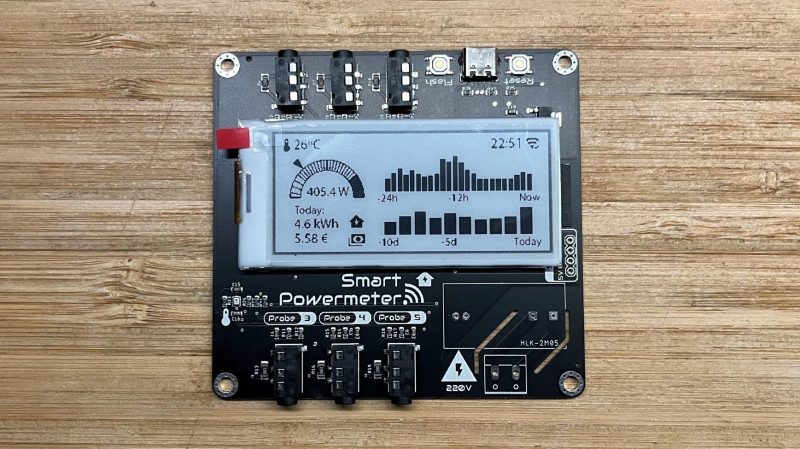In most places around the world, electricity is getting ever more expensive. Cutting back on your usage is one of the easier ways to escape this pain. This smart powermeter from [JGAguagdo] may prove a useful tool to achieve that goal.
The project uses an ESP32-S2 as the brains of the operation. It’s capable of reading up to six current-transformer clamps for measuring current draw in AC devices. It also features an embedded BMP280 temperature and air pressure sensor. Live data is displayed on a 2.9-inch e-Paper display, making it clear and easy to read under normal lighting conditions. By default, it’s set up to display graphs of power usage both over the last 24 hours, and the last ten days. It can even be set up with the prevailing energy rates in your area to display a realistic figure for what you’ll pay for your daily usage.
It can even be set up to work with Home Assistant for more logging and control options. We can imagine that, with a little work, you could even do some fancy plotting of energy use versus temperature to determine the performance and cost of your home HVAC setup.
If you want one with a minimum of fuss, you can score one on Tindie. Alternatively, design files are available on GitHub, too. We’ve featured some other great power meters over the years, and if you’re cooking up your own smart designs, don’t hesitate to let us know!
















Waiting on Hash to comment to determine the validity of this project….
HaD effect – out of stock.
It’s been out of stock for weeks, I’ve been talking to the dev.. there’s like 3 more units coming soon :( 11
Wow, reading the tindie page actually seems very promising! I like the “buy psu bundled or from supplier (link)”, very open and honest.
And especially for the PSU for a 24/7 device I’d trust it more in that configuration.
Overall otherwise as well it seems well thought out, I kind of want one. Possibly even just to get power use into home assistant, for the display my fuse box location is way down in a corner in the basement and.. possibly the worst place to have an unlit display, I actually need to redo the lightning hah.
I can’t see where in the schematic the mains voltage is sampled. Without that, the best it can do is approximate VA measurements, you can’t calculate watts without voltage. Unless you have a perfect power factor, this isn’t going to be at all accurate.
Doesn’t have to read the voltage. There is a constant ‘230.0’ in the power calculation …
… so garbage in, garbage out.
I tought the same. It reminds me of another power meter project. I think he could have gotten his inspiration from there. In the other project the low side transformer voltage was measured. Which is not particulary exact and only 1 Line ( In germany we have 3 in total)
Good catch. Maybe it should have an input voltage which is either AC and rectified and filtered onboard after sampling or an input which is only bridge rectified then sampled before filtering. But if the input source is from a buck converter and addon will be needed.
About seventy-three years too late for the “revolt”. It’s taking one’s medicine time.
As person related to energy meter mass production, I’d say this device is pure b*s. I see “temperature and humidity sensor” but I can’t see any decent ADC to perform measurements. Even cheapest power meters are equipped with “at least” 16-bit delta-sigma ADCs, with 20 and 24 bit more common. What would you save with this piece of smart garbage, I don’t know.
As electric engineer, working with professional instruments for the last 20 years, I think you are quite wrong.
With the 13bits ADC, let’s say that you want to measure up to 100A and you go with a CT clamp 100A:50mA, you could measure up to 150A with a resolution of 36mA (8W @230V). You want more resolution? Go to a CT more fitted to your range of measurement.
Look, this device is based on an ESP32-S2, so yes, it might have a “limitation” on the 13 bit ADC, but you are not spending +500$ on a professional equipment. For 20$ this board seems to measure up to 6 channels, is compatible with Home Assistant, has e-paper support, and yes, also temperature (sometimes useful to know on you electrical cabinet) and pressure (not sure what for, but ok).
It is more than enough for measuring and keeping track of a normal household’s energy expenses.
Hola Dimitri veo que sabéis bastante del tema me podrías recomendar alguna otra placa que sirva para medir hasta seis líneas ? Aunque personalmente si hay alguna placa sin pantalla ya me iría bien debido a que quiero conectividad con home assistant y poderlo administrar y visualizar desde la App de Home assistant muchas gracias por tu colaboración
Hola Marc, me da a mi que Dimitri no tiene ni papa. Estoy en tu misma situación buscando algo compatible con HA, y esta placa es más que suficiente para una instalación de una casa normal. Yo me apunté a la waitlist y le envié un mail a Jon.
i love metrics and want to measure current flow throughout my house with more granularity. but if you just want to save on your electric bill, for most of us, it’s pretty simple, just turn off your A/C :)
switching to LED lighting was a nice bump but i assume everyone’s already done that
Water heaters and refrigerators.
Water heater … natural gas.
Refrigerator … gotta keep the beer cold, no other option.
This is great, it has a nice simplicity compared to something like the iotawatt .
I do wonder is there is anything out there similar that has a higher resolution for capturing near instantaneous current draw?